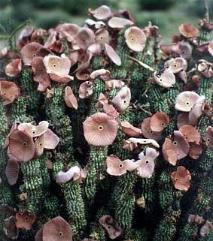|
|
Hoodia, a plant that tricks the brain by making the stomach feel full, has been in the diet of South Africa's Bushmen for thousands of years. CBS News, 60 Minutes, talking about Hoodia |
Natural herbal diet pills hoodia that stops the appetite
|
|

Hoodia gordonii, "Whoo De AH", is the botanical name for a leafless, spiky succulent plant that grows throughout the semi-arid areas of Southern Africa primarily the Kalahari desert. The San (local inhabitants) have rationally used Hoodia stems to stave off hunger and thirst when on long journeys, as it acts as an appetite suppressant. Hoodia is a Succulent botanical and is part of the Genus: Trichocaulon and belongs to the Family Name: Asclepiadaceae. There are approximately twenty plants within the Hoodia genus family, however, Hoodia Gordonii is the unique plant that South African San bushmen have used for generations to endure long hunting expeditions. Hoodia Gordonii is a leafless spiny succulent plant ( not a cactus ) with fleshly finger-like stems. Rows of thorns are present along the stems, bearing flesh coloured flowers. Hoodia Gordonii grows naturally in the harsh desert conditions of South Africa. Now Hoodia Gordonii has been found in the semi-deserts of Zambia, Zimbabwe, Botswana, Namibia, Angola, the Republic of South Africa, and now found in some other arid regions of South American Nations such as Chili, Peru and some regions of West China including Gansu, Sichuan and Shanxi. Scientists at the South African Center for Scientific and Industrial Research were the first to successfully prove that Hoodia contains a miracle molecule that suppresses the appetite. Later, a human clinical trial was conducted by scientists in Leicester England. A group of morbidly obese men and women participated. Half the group were given Hoodia and half were given a placebo. At the end of 15 days, the group on Hoodia had reduced their food intake by 1000 calories a day. Given the average daily diet is around 2200 calories, this was a stunning success. It has been established that the P57 molecule found in wild harvested Hoodia Gordonii works by mimicking the effect that glucose has on nerve cells in the brain in effect fooling the body into thinking it is full, even when it is not, thus curbing the appetite. Laboratory experiments show animals automatically restrict their food intake when taking hoodia orally. Rats, a species that will eat anything from meat and plants to indigestible fiber, lowered their dietary calorie intake to a degree that made them get thin when fed comparative amounts of hoodia. Hoodia is registered as a protected species to prevent Bio-Piracy but is allowed to be grown on a handful of commercial farms in South Africa owned by private farmers. In the wild Hoodia takes 5-6 years to mature but is now being cultivated in as little as 2 years commercially in sustainable quantities and has become widely known for its effects as an appetite suppressant. Hoodia Gordonii is a plant - a leafless succulent. Not a Cactus nor a Herb. In South Africa Hoodia Gordonii is classified as a foodstuff, which is testimony to how safe the product really is. There are 13 species of Hoodia which are native to Southern Africa but ONLY ONE variety - the "Gordonii" has the needed natural ingredients for weight loss. If you purchase the cheap imitation products sold by people out of their garage that you see on EBAY, and in the Google and Yahoo ads you will NOT have the results shown on the Personal Diet Results pages. Folks I have been through this over and over - read about the nineteen companies that have sent me Hoodia Gordonii Cactus products to test and how only a couple of them really work. All over the world, people are trying to buy hoodia, and there just isn't enough supply to go around. The succulent growers have been wiped out. The seed providers have virtually no inventory left. And since hoodia takes more than six years to grow to harvesting height, there's going to continue to be a great hoodia shortage until at least 2010, maybe beyond. So buying hoodia is very difficult. It's expensive. And, naturally, there are a lot of fakes on the market. Even now, there are only a few hundred acres of hoodia growing on commercial farms, and the plant is highly susceptible to being wiped out by rather mysterious conditions.
Web directory for the internet search for smart people.
|
|
Information on this web page named Natural herbal diet pills hoodia that stops the appetite and related to Hoodia, Weight loss is provided for informational purposes only and is not a substitute for professional medical advice. You should not use the information on this web site for diagnosing or treating a medical or health condition of Hoodia or Weight loss. If you have or suspect you have a medical problem, promptly contact your professional healthcare provider. Talk to your doctor, nurse or pharmacist before following any medical regimen to see if it is safe and effective for you. © Copyright 2007 Health Community of Canada, Weight loss area. |
